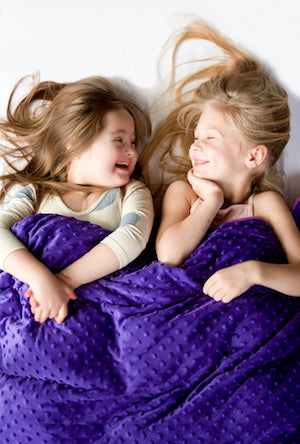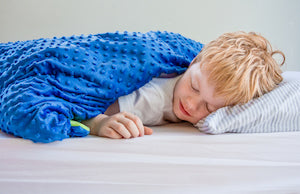Your Cart is Empty
Save up to 20% on all Harkla products & courses during Autism Acceptance Month! Click Here to See the Sale

Before we discuss whether or not weighted blankets can benefit toddlers, let's cover a couple of principles for safely using a weighted blanket.
Please be advised that weighted blankets are not recommended for children under the age of 2 years old. So, when we refer to toddlers in this article, we are referring to children ages 2-3 years old.
For those looking for information about supporting the sleep needs of children younger than 2-year-olds, we wrote a related article about babies using weighted blankets.
Keeping this in mind, be sure to use a safe weight. Since the average weight of toddlers between the ages of 2-3 years old is 20-30 pounds, the recommended weight (10% of body weight plus 1-2 pounds) would be no more than 5 pounds.
5-pound blankets are pretty light and can be difficult to come across. If you are interested in one, we do carry 5-pound weighted blankets here at Harkla.
If something smaller is needed, we do carry a 5-pound weighted lap pad as well.

Many toddlers struggle with sleep, which means that their parents inevitably do, too. It’s a common topic in social circles, parent support groups, with family, and the pediatrician.
Some toddlers were babies who historically have been “good sleepers” and others seem like they have never learned to sleep. And even when you think you’ve got your child figured out, some seem to change their sleep patterns overnight, without explanation. Sleep is one of those basic human needs and it affects the whole family.
You would do anything to catch some extra minutes of that sweet sleep! Many parents are purchasing weighted blankets to help their toddlers sleep better during nap time and at night.

Historically, weighted blankets were designed as a deep pressure input technique to help individuals with special needs. They have often been recommended by occupational therapists for patients receiving treatment - children on the autism spectrum, attention deficit disorder diagnoses, and sensory processing disorders.
Now, weighted blankets are available for purchase by the general public; through the internet, at specialty stores, and even craft fairs; as well as DIY tutorials on how to make your own weighted blanket on Pinterest.
It’s certainly an easy decision to want to try one, as long as you are educated about its use. When compared to other sleeping tools/aids/protocols, they aren’t prescribed by a doctor, don’t involve medication with potential side effects, or come with a detailed behavioral plan that is hard to carry out. Most children welcome the idea of trying something new, especially something soft and pleasing that they helped to pick out themselves.

But are they effective? How do you know if using a weighted blanket for toddlers will work? The therapy community stands behind them. Most parents who start using a weighted blanket have found it to make a positive difference in their child’s sleep.
Is approval by another parent enough to try a weighted blanket for your own toddler? While it is difficult to find a specific study to answer this question, there are several pieces of research that can help put together pieces of this puzzle.
One study found positive results for sleeping patterns in young children with and without developmental disabilities when they used a weighted blanket.
Another examined the use of weighted blankets for sleep in autistic children specifically, and again there were positive results.
When considering the conclusions of each research study, signs point to weighted blankets being effective.
Effective for different types of children, effective for different ages of children, which one can assume will be effective for toddlers.
Research studies examining weighted blankets for toddlers revealed several conclusions that are helpful to parents considering using one. With weighted blankets being a deep pressure input technique, it is proven to lower anxiety in the user. While we hope that toddlers don’t have real anxieties that prevent them from sleeping, we know that pressure input is calming. Establishing a calming bedtime routine is important for any child who is about to enter sleep.
Another measured outcome of using a weighted blanket involves lowering EDA – electrodermal activity. EDA is used in medicine and research – its measurement property in the skin, completely unconscious in the individual. EDA is driven by the sympathetic nervous system which is in charge of behavioral, emotional, and cognitive states.
Lowered EDA indicates less stirring and lower extraneous movement throughout a sleep cycle – this means deeper sleep for an individual. Weighted blankets can deliver constant input throughout the night, and can help in between sleep cycles, or when a child might awaken. Keeping EDA lower can help keep a child asleep.
One common conclusion that many studies about toddler weighted blankets have made is about tolerance. Children tended to tolerate a weighted blanket better than other modes of input and chose a weighted blanket more often than other sleep supports available. As compared to other sleep-related strategies or treatments, a weighted blanket was considered a preferred modality.
As many parents know, toddler buy-in is important. Knowing that a weighted blanket might be “toddler approved” is crucial in making the decision to integrate it into a sleep routine.

While there isn’t any specific hard-and-fast research to support weighted blanket use explicitly for toddlers, there is enough information to recommend them to be effective for many youngsters with and without disabilities.
They are widely available to parents and often toddler approved. Many other families and the pediatric therapy community will recommend them for trial.
Remember that they don’t have to be used solely for sleep – snuggle time with books, use as part of a wind-down routine before bed – the possibilities are endless.
So, if you’re considering using a weighted blanket to help your toddler sleep better, make sure that you understand the formula to select the correct size and weight. For your own purposes, keep track of how long it takes for your child to enter sleep, and if they wake in between sleep cycles – it will help you measure whether or not it’s making a difference. Hopefully, you too will get some extra sleep!
How does this work for 3.5 yo that also chew on blankets, is there a safe brand for chewers?
Hi Mary,
Thank you for insight on this article. I want to restate the author’s closing thoughts:
“While there isn’t any specific hard-and-fast research to support weighted blanket use explicitly for toddlers, there is enough information to recommend them to be effective for many youngsters with and without disabilities.”
I think she is just saying that if your toddler has trouble sleeping, it might be worth trying a weighted blanket. There are never any guarantees and weighted products certainly don’t work for everyone. But if a weighted blanket does help, it can be a game changer for the child and parents!
Be careful of this article. The studies sited don’t actually say what the author claims. The article linked in this sentence “One study found positive results for sleeping patterns in young children with and without developmental disabilities when they used a weighted blanket” does not say anything about weighted blankets. It only confirms that children with ASD typically have difficulties with sleeping. The article linked in this sentence, “Another examined the use of weighted blankets for sleep in autistic children specifically, and again there were positive results” only looked at TWO children and it’s results state that there were “minimal changes” when weighted blankets were used.
Comments will be approved before showing up.



Nicole
March 20, 2019
Hey Julie,
Thanks for the question. I’m really sorry that I don’t know of a blanket that is guaranteed safe for someone who chews. Our blanket wouldn’t cause any issues and is not toxic in any way. So if your child were to chew on it, I think he would be fine. I would wash it first with eco-friendly laundry detergent. Another option is to look into a chew pendant that can attach to the blanket. That might help!
Hope this helps!
Nicole
Harkla Happiness Ninja